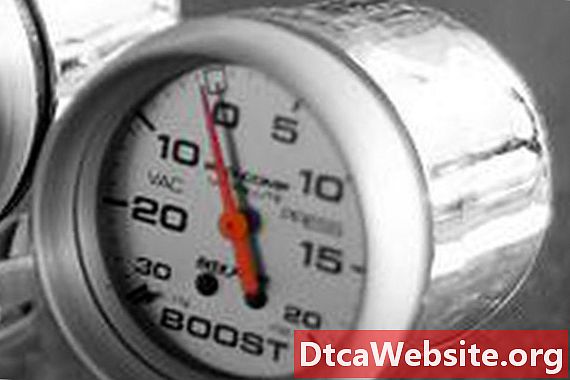
Contenu

Turbo-charged engines are becoming more popular as smaller engine packages are utilizing external components to increase the power output that an engine can produce. A turbocharged engine is equipped with a rotating compressor that uses exhaust gases to generate huge amounts of compressed air for the engine to burn during combustion. Because a turbo takes exhaust gases to create cool, dense air for the engine to burn, a turbo operates after the initial acceleration has been initiated. A quality turbo boost gauge is needed to operate a high performance turbo correctly and without causing damage to the engine during use.
Step 1
Position the turbo-charged vehicle over a dynamometer or drive to a location where a testing of the turbo can be performed. Prepare some notes that can be used as a guide to operating the equipped turbo properly by using the individual characteristics the turbo produces. A turbo boost gauge is capable of reading all the different boost pressures that occur during operation, but to read the boost gauge correctly you need to operate the vehicle under different situations and mark the differences in boost and power gains.
Step 2
Start the car and warm it to an operating temperature that is normal after driving for 15 minutes. Bring the car to a complete stop and mark the boost pressure that is present at that location. This would be the base boost pressure that your turbo is producing when idling normally. With the car in neutral apply enough gas to create a high rev of the engine--2500-3000 RPM should be enough to see an increase in the turbo boost. Now place the car in gear and attempt a dead stop, low RPM take-off. Watch the RPM and note how long it takes to get the turbo spooled up and producing boost in the positive boost range. These two notes will allow you to produce enough RPM at the start line to have the turbo spooled up and ready to race. Without having initiated an increase in RPM before take off, a turbo will lag until the RPM is high enough to get the turbo pushing air.
Step 3
Execute a number of driving situations that will test the turbo-charged engines response. Taking these tests to the limit of normal operation will show how different boost gauge readings are representative of engine environments that perform well or poorly, or may be harmful to the engine itself. Finding the high boost reading after operating for an extended period will signal that the engines temperatures may be too high for safe, reliable operation. As more boost is generated, extra fuel and spark creates pressures and heat levels that will damage an engine quickly. Knowing what your boost gauge is saying is important in operating within the limits of the turbo-charged engine.
Refer to the notes that were taken during the turbo boost testing. Mark the highs and lows of operational performance by marking the dial of the turbo boost gauge with a permanent marker. Done with an opaque ink, the measurements may be read during daylight or nighttime hours with the help of the gauges illumination light. Now that the marks can be clearly seen, operating a turbocharged engine in any type of traffic or race is easier, with the knowledge to run the turbo properly.
Tip
- Include a wastegate valve on a turbo to prevent producing too much boost during use. A properly set wastegate valve allows for performance operation and practical dumping of harmful turbo boost in extreme conditions.
Warning
- Running high RPM motors on turbocharged induction systems makes them vulnerable to damage from extreme engine heating conditions. Knowing how to read a turbo boost gauge will help prevent this from happening.
Items you will need
- Dynamometer/Driving course
- Notebook
- Pencil


